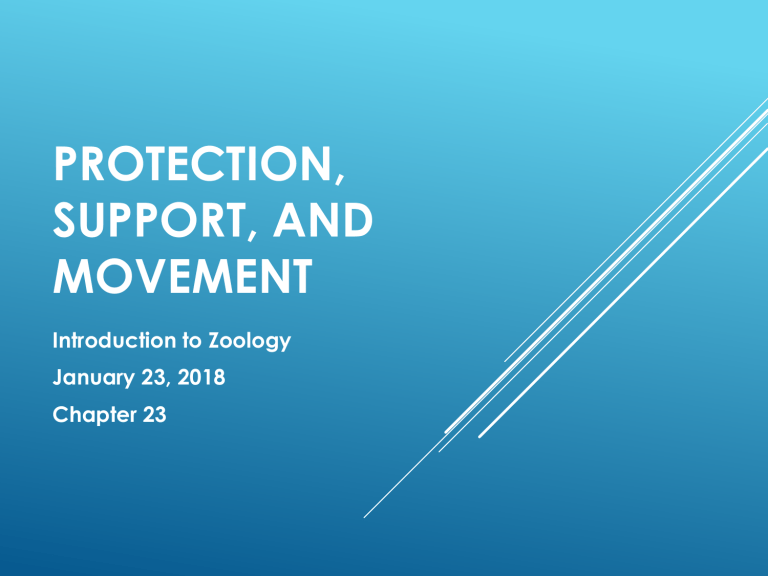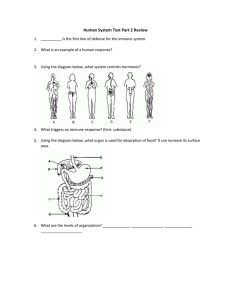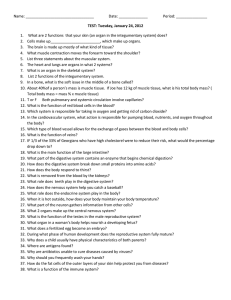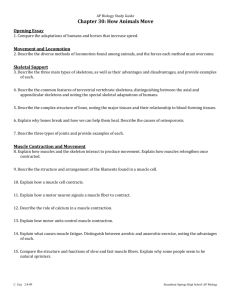
PROTECTION,
SUPPORT, AND
MOVEMENT
Introduction to Zoology
January 23, 2018
Chapter 23
TODAY WE WILL
Review
the function of the integument
and basic differences among types of
organisms
Review
the basic differences between
animal skeletons
Have
a general understanding of how
animals move
SO….WHAT IS
INTEGUMENTARY??
The integumentary syste
m comprises the skin
and its appendages
acting to protect the
body from various kinds
of damage, such as loss
of water or damages
from outside.
The integumentary syste
m includes hair, scales,
feathers, hooves, and
nails
PROTECTION: INTEGUMENTARY
SYSTEMS
The
integument is the external covering of an
animal.
It
primarily protects against mechanical injury and
invasion by microorganisms.
Integumentary
Regulation
Excretion
Vitamin
functions also include:
of body temperature
of waste materials
D3 formation
PROTECTION: INTEGUMENTARY
SYSTEMS (CONTINUED)
Reception
of environmental stimuli:
Pain
Temperature
Pressure
THE INTEGUMENTARY SYSTEM OF
INVERTEBRATES
Protozoans
plasma
membrane
Pellicle:
thick covering around
plasma membrane
Invertebrate
integument
single
layer of epithelial cells =
epidermis
Specializations
include cuticles,
shells, or teguments
Figure 23.1 Integument of Invertebrates.
Protective cuticle
Figure 23.2 An insect cuticle.
VERTEBRATE INTEGUMENT = SKIN
Figure 23.3
Skin of Jawless Fishes: thick skin
Figure 23.4 Skin of Cartilaginous Fishes: multilayered
and contains mucous and sensory cells .
Figure 23.5 Skin of Bony Fishes: contains scales
composed of dermal bone
Figure 23.6 Skin of Amphibians: stratified
epidermis and a dermis containing mucous and
serous glands plus pigmentation cells
Figure 23.7 Skin of Reptiles: dry, no epidermal
glands
Figure 23.8 Skin of Birds: like reptiles, no epidermal
glands, covered with feathers
Figure 23.9 Skin of Mammals: several layers of a variety of cells, including
hair shafts, glands, blood vessels, thick dermis (middle layer)
VERTEBRATE INTEGUMENT
Hair:
keratin-filled dead cells that
develop from the epidermis.
Nails/claws:
epidermis
modifications of the
flat, horny plates on the dorsal
surface of the digits.
VERTEBRATE INTEGUMENTARY SYSTEM
TODAY WE WILL:
Review
the function of the
integument and basic
differences among types of
organisms
Review the basic differences
between animal skeletons
Have a general understanding
of how animals move
THE SKELETAL SYSTEM
Animals
have three types of skeletons:
Hydrostatic
skeletons
Exoskeletons
Endoskeletons
HYDROSTATIC SKELETON
HYDROSTATIC SKELETON
Changing shape: Because the fluid volume is
constant, a change (increase) in width must
accompany a change (decrease) in length.
Core of liquid (water or a body fluid such as blood)
surrounded by a tension-resistant sheath
EXOSKELETON
Rigid
exoskeletons provide sites for
muscle attachment and counterforces
for muscle movements.
Exoskeletons
the body.
also support and protect
Figure 23.11b
Articulation of
an arthropod
limb.
VERTEBRATE SKELETON:
ENDOSKELETON
Two
main types of supportive tissue:
Cartilage
Provides a site for muscle attachment
Aid in movement at joints
Provides support
Bone
Provides a point of attachment for
muscles
Transmits the force of muscle contraction
from one part of the body to another
Figure 23.12
Bone.
Figure 23.13
Fish
Endoskeleton.
Figure 23.14 Tetrapod Endoskeleton (frog)
Vertebrate skeleton:
• Longer appendages (legs and arms)
• The vertebral column adapted to
more dorsoventral (front to back)
motions than to side-to-side
movements
TODAY WE WILL
Review the function of the
integument and basic
differences among types of
organisms
Review the basic differences
between animal skeletons
Have a general
understanding of how
animals move
LEARNING OUTCOMES: SECTION
23.3
Describe
three types of
nonmuscular movement.
Explain
the sliding-filament
mechanism of muscle
contraction.
MOVEMENT: NONMUSCULAR MOVEMENT
AND MUSCULAR SYSTEMS
Movement (locomotion) is characteristic of
certain cells, protists, and animals.
The contractile proteins actin and myosin
are involved.
Nonmuscular movement involves the
following structures:
Pseudopodia
Cilia
Flagella
AN INTRODUCTION TO ANIMAL
MUSCLES
Animals
may have one or more of
the following types of muscle
tissue:
Smooth
muscle: involuntary
muscle movements
Cardiac
muscle: involuntary,
found in heart
Skeletal
Muscle
muscle: voluntary
tissue exhibits contractility,
excitability, extensibility, and
elasticity.
INVERTEBRATE MOVEMENTS
Locomotion
of soft-body invertebrates:
Pedal
locomotion in snails and
planarians
Successive
muscle contraction in
earthworms
Looping
movements in leeches
Water-vascular
echinoderms
Terrestrial
system of
locomotion in
invertebrates also involves walking
Flight
Jumping
Figure 23.17 Successive
Stages in Earthworm
Movement.
Figure 23.18 Looping
Movements.
Figure 23.20 WaterVascular System of an
Echinoderm.
Insert figure 23.22 Walking: Limb Trajectories of Several
Arthropods
Figure 23.23 Jump of a Flea.
THE MUSCULAR SYSTEM OF VERTEBRATES
Figure 23.24a Fish Musculature.
Most of the musculature of fishes consists of segmental
myomeres.
Figure 23.25 Structure
of Skeletal Muscle
Tissue.
Figure 23.26 SlidingFilament Model of
Muscle Contraction:
myofilaments slide
within myofibrils
Figure 23.27 Nerve-Muscle Motor Unit:
• Nerves control skeletal muscle contraction.
• The process of contraction is controlled by calcium ions
Copyright © 2016 McGraw-Hill Education. All rights reserved. No reproduction or distribution
without the prior written consent of McGraw-Hill Education.
QUESTIONS?







